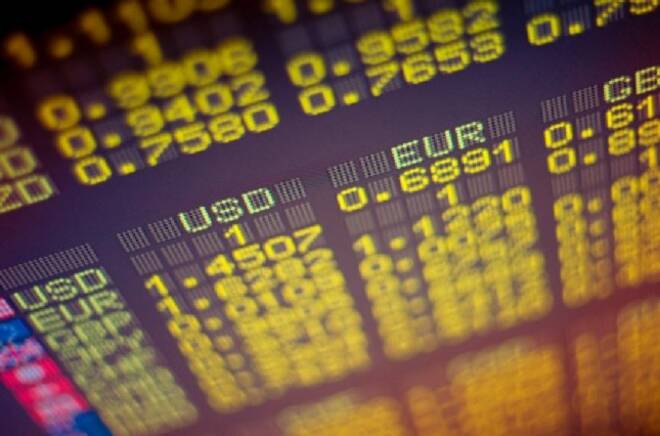Advertisement
Advertisement
EUR/USD Technical Analysis for March 1, 2018
By:
The EUR/USD continued to move lower as bund yields declined at a fast rate than treasuries. The Eurozone February inflation figures fell back while German
The EUR/USD continued to move lower as bund yields declined at a fast rate than treasuries. The Eurozone February inflation figures fell back while German jobless numbers declined. French inflation number were weaker than expected while German consumer confidence was softer than expected.
Technicals
The EUR/USD moved lower after breaking through trend line support on Tuesday. Prices are holding near the prior February lows at 1.2205, and a close below this level would lead to a test of an upward sloping trend line near 1.21. Momentum remains negative as the MACD (moving average convergence divergence) histogram prints in the red with a downward sloping trajectory which points to lower prices. The fast stochastic recently generated a crossover sell signal but the current reading of 5, is below the oversold trigger level of 20 and could foreshadow a correction.
Eurozone February HICP inflation fell back
Eurozone February HICP inflation fell back to 1.2% year over year from 1.3% year over year. The correction is in line with consensus and less pronounced than German and French data had suggested and as we expected core inflation actually held steady, as most of the dip in the headline rate was due to base effects from energy and in particular food prices.
German jobless numbers declined
German jobless numbers declined -22K – more than anticipated and leaving the jobless rate at just 5.4% year over year. Employment rose 60K in January, the last number for which data are available and vacancies lifted slightly in February. So despite the drop in business confidence numbers this month, the labor market continues to improve and companies remain sufficiently optimistic about the outlook to take on more staff, which ties in with the results of the PMI surveys. More arguments then for Weidmann, who highlighted recent German wage deals as a sign that underlying inflation will continue to move higher.
Switzerland’s February KOF leading indicator beat forecasts
Switzerland’s February KOF leading indicator beat forecasts, at 108.0 in the headline outcome, unexpectedly gaining on the 107.6 reading seen in January. The median forecast had been for decline to a 106.0 reading. The combo of a weaker franc, which is down by nearly 10% versus the euro versus year-ago levels, although still deemed overvalued by the SNB, along with strengthening Eurozone and global economic growth have been a boon to the export oriented Swiss economy.
French Q4 GDP was confirmed
French Q4 GDP was confirmed at 0.6% quarter over quarter with the second reading, while the annual rate was revised higher to 2.5% year over year from 2.4% year over year reported initially. The breakdown showed a sharp rise in exports of 2.4% quarter over quarter, which outstripped the 0.3% quarter over quarter rise in imports that quarter. Household consumption, usually the driver of French growth, rose only 0.2% quarter over quarter, after still expanding 0.6% quarter over quarter in Q3. Gross Fixed Capital Formation meanwhile accelerated to 1.2% quarter over quarter from 0.9% quarter over quarter.
French HICP inflation weaker than expected at 1.3% year over year, down from 1.5% year over year. Expectations had been for a steady headline reading, but in the event the annual rate dipped once again, with a drop in food prices a main factor. Energy price inflation held steady at 5.2% year over year, but prices for fresh food dropped -1.5% year over year, after rising 1.8% year over year in January. Tobacco price inflation also decelerated sharply, services price inflation eased to 1.1% year over year from 1.3% year over year but prices for manufactured goods rose 0.1% year over year, after stagnating in January.
German GfK consumer confidence dipped
German GfK consumer confidence dipped to 10.8 with March numbers from 11.0 in February. An unexpected correction after the surprisingly strong February numbers. The full details for February, only available now, show economic expectations falling back in tandem with income expectations and the willingness to buy, although the willingness to save turned even more negative. Overall readings remains at very high levels, like business confidence surveys, but suggest some levelling off which will back the arguments of the ECB doves for caution with regard to any changes in guidance.
Fed Chair Powell’s testimony to congress confirmed that the FOMC will continue to gradually reduce accommodation. Notably he said the “FOMC will continue to strike a balance between avoiding an overheated economy and bringing PCE price inflation to 2 percent on a sustained basis. While many factors shape the economic outlook, some of the headwinds the U.S. economy faced in previous years have turned into tailwinds.” The economic outlook remains strong, and fiscal policy is becoming more simulative, while foreign demand for U.S. exports is on a firmer path.
About the Author
David Beckerauthor
David Becker focuses his attention on various consulting and portfolio management activities at Fortuity LLC, where he currently provides oversight for a multimillion-dollar portfolio consisting of commodities, debt, equities, real estate, and more.
Did you find this article useful?
Latest news and analysis
Advertisement
